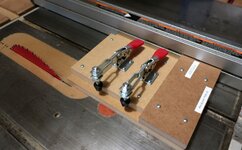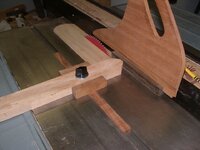gtriever
Member
A case of overkill - but it works.
I've had quite a few pen blanks show up that are not square (3/4 x 3/4, etc) and trying to square such small pieces on the table saw makes me a little nervous, even with a push block. So, I cobbled this together to make life a little easier. It slides along the saw's Rip Fence and keeps my fingers away from the blade. With spacers and double-sided tape I can also use it for thin rips off the blanks:

I've had quite a few pen blanks show up that are not square (3/4 x 3/4, etc) and trying to square such small pieces on the table saw makes me a little nervous, even with a push block. So, I cobbled this together to make life a little easier. It slides along the saw's Rip Fence and keeps my fingers away from the blade. With spacers and double-sided tape I can also use it for thin rips off the blanks:


